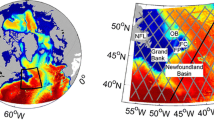Summary
The Gulf of Mexico (GOM) circulation is simulated using the DieCAST ocean model, with a horizontal resolution of 1/12° and 20 vertical layers. The results compare well with observations of both large and small scale features, including Loop Current frontal occlusions associated with frontal eddies. The simulation is carried out without any data assimilation. The frontal eddies tend to be spaced at about 90° intervals around the Loop Current, leading to a Loop Current head shaped like a square with rounded corners. The pattern rotates as the eddies circle the Loop, and frontal eddies elongate as they squeeze through the Florida Strait. Major warm core eddies separate regularly from the Loop Current and propagate to the western GOM. Old warm core eddies in the western Gulf dissipate through bottom drag effects, which also generate cyclonic parasitic eddies. Newly arrived warm core eddies merge with old ones in the western GOM. Recently separated elongated Loop Current eddies can rotate and reattach temporarily to the Loop Current. The barotropic flow component develops eddies between the main separated warm core eddy and the Loop Current due to eastward dispersion, as the main eddy itself propagates westward into the Gulf.
Similar content being viewed by others
References
Arrango, H. G., Reid, R. O., 1991: A generalized reducedgravity ocean model.Atmos. Ocean,29, 256–287.
Blumberg, A. F., Mellor, G. L., 1985: A simulation of the Circulation in the Gulf Mexico.Isr. J. Earth Sci.,34, 122–144.
Cresswell, G. R., 1982: The coalescence of two East Australian Current warm-core eddies.Science,215, 161–164.
Cresswell, G. R., Legeckis, R., 1986: Eddies off southeastern Australia.Deep-Sea Research,33, 1527–1562.
Dietrich, D. E., Marietta, M. G., Roache, P. J., 1987: An ocean modeling system with turbulent boundary layers and topography: numerical description.International J. Num. in Fluids,7, 833–855.
Dietrich, D. E., Roache, P. J., Marietta, M. J., 1990: Convergence studies with the sandia Ocean Modeling System.International J. Num. Methods in Fluids 11, 127–150.
Dietrich, D. E., 1992: The Sandia Ocean Modeling System Programmers Guide and Users Manual, SAND93-7386. SAND92-7386 Sandia National Laboratories, Albuquerque, NM 87185.
Dietrich, D. E., Lin, C. A., 1994: Numerical studies of eddy shedding in the Gulf of Mexico.J. Geophys. Res.,99, 7599–7615.
Dietrich, D. E., Ko, D.-S., 1994: A semi-collocated ocean model based on the SOMS approach.International J. Num. Methods in Fluids,19, 1,103–1,113.
Dietrich, D. E., Ko, D.-S., Yeske, L. A., 1994: On the application and evaluation of the relocatable DieCAST ocean circulation model in coastal and semi-enclosed seas. Technical Report 93-1, Center for Air Sea Technology, Mississippi State University, Stennis Space Center, MS 39529-6000.
Hamilton, P., 1993: Hydro/drifter data at shelf edge. LATEX III Meeting, October 27–28, 1993, New Orleans, LA.
Haney, R. L., 1971. Surface boundary condition for ocean circulation models.J. Phys. Oceanogr.,1, 241–248.
Haney, R. L., Dietrich, D. E., 1996: A model simulation of wind and boundary forced jets in the coastal ocean off central California, Proceedings of the 76th American Meteorological Society Annual Meeting, Atlanta, GA, 28 Jan-2 Feb, 1996 (invited presentation, with color cover feature).
Hellerman, S., Rosenstein, M., 1983: Normal monthly windstress over the world ocean with error estimates.J. Phys. Oceanogr.,13, 1093–1104.
Hurlburt, H. E., Thompson, J. D., 1980: A numerical study of Loop Current instrusions and eddy shedding.J. Phys. Oceanogr.,10, 1611–1651.
Ko, D.-S., 1992: Synthetic temperature profile in the Gulf of Mexico: Part 1. Statistical relationship between model amplitudes and dynamic height at surface. Institute for Naval Oceanography report TM-8.
Levitus, S., 1982: Climatological atlas of the World Ocean. NOAA Prof. Paper 13, U.S. Dep. of Commerce, Washington, D.C., 173 pp.
Lewis, J. K., Kirwan, A. D., Jr., 1987, Genesis of a Gulf of Mexico ring as determined from kinematic analysis.J. Geophys. Res.,92, 11,727–11,740.
Lewis, J. K., Hsu, S. A., 1992: Mesoscale air-sea interactions related to tropical and extratropical storms in the Gulf of Mexico.J. Geophys. Res.,97, (C2), 2215–2228.
Lin, C. A., Dietrich, D., 1994. A numerical study of low Reynolds number 2-dimensional convective adjustment.Geophys. Astrophys. Fluid Dyn.,74, 123–134.
Schmitz, W. J., Richardson, P. L., 1991: On the sources of the Florida Current.Deep Sea Res.,38, S379-S409
Smith, D. C., IV, 1986: A numerical study of Loop Current eddy interaction with topography in the western Gulf of Mexico.J. Phys. Oceanogr.,16, 1260–1272.
Vukowich, F. M., Maul, G. A., 1985: Cyclonic eddies in the Eastern Gulf of Mexico,J. Phys. Oceanogr.,15, 105–117.
Wallcraft, A. J., 1986: Gulf of Mexico circulation modeling study, Annual propress report: Year 2, Report to Minerals Management Service, 94, pp. JAYCOR, Vienna, Va.
Author information
Authors and Affiliations
Additional information
With 10 Figures
Rights and permissions
About this article
Cite this article
Dietrich, D.E., Lin, C.A., Mestas-Nunez, A. et al. A high resolution numerical study of Gulf of Mexico fronts and eddies. Meteorl. Atmos. Phys. 64, 187–201 (1997). https://doi.org/10.1007/BF01029692
Received:
Revised:
Issue Date:
DOI: https://doi.org/10.1007/BF01029692



